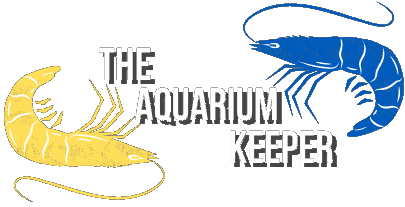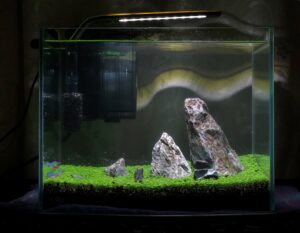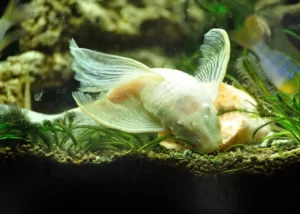
7 Amazing Smallest Freshwater Shrimp You Should Keep

Writer at The Aquarium Keeper
There are a lot of different smallest freshwater shrimp options, that anyone could keep with some knowledge. Freshwater shrimp are a very popular aquatic option if you are looking for something besides fish. These creatures have a unique personality, are completely peaceful, and can be great aquatic companions! In this article, I will break down 7 different smallest freshwater shrimp, that you should consider keeping.
Guidelines For a Shrimp Tank
There are a lot of different shrimp tank setups that you can think of, but there are some universal guidelines for a shrimp aquarium, that I would like to talk about. First of all, I would recommend, that you should get at least a 10-20 gallon aquarium for any kind of shrimp. The more space there is for these aquatic creatures, the better they will feel.
Another important thing is that every shrimp tank has to have the necessary equipment. For example, a sponge filter should be installed in every tank, because it helps to maintain clean water, and does not accidentally suck shrimp into the filtration system. A heater and lightning are also necessary, since you need to see your shrimp, and a heater helps maintain water temperature.
When it comes to more esthetical features of a shrimp tank, be sure to include a lot of live aquarium plants, and other decorations, that would provide lots of hiding places for any kind of shrimp. There are countless aquatic plants for a shrimp tank that you can choose from, and most of them are very easy to take care of.
Smallest Freshwater Shrimp
To begin this list, I would like to mention, that I picked the most available shrimp in this hobby. You should be able to find these species in most aquatic stores. Nevertheless, there might be some other aquatic shrimp species that I might not include in this list, but the main reason for that is limited global availability.

Neocaridina Shrimp
Firstly, the most popular smallest freshwater shrimp is the neocaridina shrimp. These species are probably the best shrimp for beginners, and there are a lot of neocaridina shrimp colors to choose from.

Neocaridina shrimp are peaceful omnivores, that enjoy exploring their surroundings, eating algae, and breeding extensively. They are widely available anywhere, but the more delicate color of neocaridina shrimp can sometimes be pricy. Here is more information about neocaridina shrimp:
- Water Temperature: 15–30 °C (59–86 °F)
- pH: 6.5–8.0
- Water Hardness: 100—200 ppm
- Minimum Tank Size: 10 gallons
- Stocking: 2 neocaridina shrimp per gallon
- Diet: Omnivorous (can eat algae, plankton, leftover fish food, and plant matter)
- Lifespan: 1-2 years
- Size: up to 1.5 inches
- Care Level: Easy
It is also recommended, that you keep only one type of neocaridina shrimp since multiple colors can easily breed with each other, creating “wild-type” neocaridina shrimp, and ruining the coloration. Wild-type neocaridina shrimp are usually grey or brown and are less appealing than the more delicate color neocaridina species.
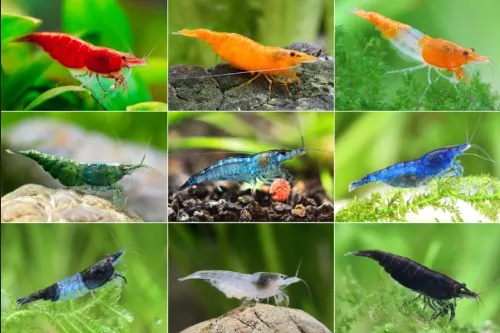
Selectively bred Neocaridina Shrimp Pack for purchase in the United States. Live arrival guaranteed!

Caridina Shrimp
Another interesting and widely available smallest freshwater shrimp species is the caridina shrimp. Compared to neocaridina, these species are more challenging, but at the same time look way more beautiful.

These species are way more pricy than neocaridina shrimp since it is harder to replicate the right environmental conditions for caridina shrimp. They need precise parameters to fully thrive and breed. Here is more information about caridina shrimp:
- Water Temperature: 20–24 °C (68–75 °F)
- pH: 6.0–7.0
- Water Hardness: 100—200 ppm
- Minimum Tank Size: 10 gallons
- Stocking: 2 caridina shrimp per gallon
- Diet: Omnivorous (can eat algae wafers, plant matter, deceased tank mates, and blanched vegetables)
- Lifespan: 1-2 years
- Size: 1-1.5 inches
- Care Level: Easy
- Special Conditions: Can only live in acidic soft water. For caridina shrimp, you will need to use a special substrate or use supplements to lower the pH of the water constantly.
Caridina shrimp are also very peaceful and enjoy just simply exploring their surroundings, and eating algae and other foods. There are some cool-looking shrimp, that you can choose from, like metallic caridina shrimp, or blue bolt caridina shrimp. Either way, be sure to do some research before purchasing caridina shrimp because they are expensive, and losing them because of a lack of knowledge would be a terrible mistake.

Selectively bred Caridina Shrimp Pack for purchase in the United States. Live arrival guaranteed!

Amano Shrimp
Moving on, another relatively popular small freshwater shrimp is the amano shrimp. These species are easy to take care of, but slightly larger than neocaridina or caridina shrimp.

These species are considered one of the hardest shrimp to breed since the shrimp eggs need brackish water to survive. Amano shrimp can get pregnant in freshwater, but that would usually result in the eggs not hatching. Here is more information about these species:
- Water Temperature: 18–27 °C (64–80 °F)
- pH: 6.0–7.5
- Water Hardness: 200 ppm
- Minimum Tank Size: 10 gallons
- Stocking: 1 amano shrimp per 2.5 gallons
- Diet: Omnivorous (can eat algae, wafers, leftover fish food, deceased tank mates, and plant matter)
- Lifespan: 2-3 years
- Size: up to 2 inches
- Care Level: Easy
Another interesting fact about amano shrimp is that you can find these species in multiple colors (greenish, brownish, greyish), and it solely depends on the food and the environment of the amano shrimp. Male amano shrimp also have a different pattern on their body, mostly covered by dots, while females have stripes that go from head to tail.
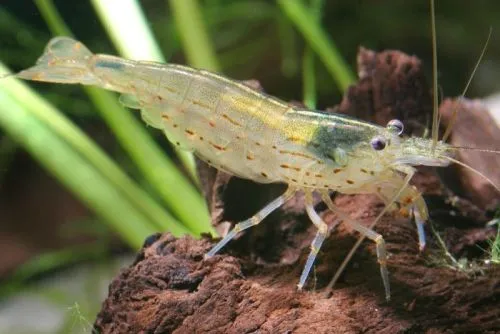
Selectively bred Amano Shrimp for purchase in the United States. Live arrival guaranteed!

Ghost Shrimp
Moving on, a lot of people confuse amano shrimp with ghost shrimp, but these two are completely different species. Both have slightly transparent bodies, but ghost shrimp is still more transparent, hence the name.

Ghost shrimp are about the same size as neocaridina shrimp, making them also one of the smallest freshwater shrimp. These species have a slightly curved body and can be hard to spot in an aquarium since they are good at blending into their environment. Here is more information about ghost shrimp:
- Water Temperature: 22–28 °C (72–82 °F)
- pH: 7.0–8.0
- Water Hardness: 150–200 ppm
- Minimum Tank Size: 5 gallons
- Stocking: 2 ghost shrimp per gallon
- Diet: Omnivorous (can eat algae, plant matter, deceased tank mates, and fish food)
- Lifespan: Up to 1 year
- Size: up to 1.5 inches
- Care Level: Easy
One interesting thing about ghost shrimp is that the life span of these species is relatively short, compared to other smallest freshwater shrimp on this list. Ghost shrimp can sometimes be slightly harder to come by since it is not as popular as neocaridina or amano shrimp.
Whisker Shrimp
Moving on, another slightly less popular, but still one of the smallest freshwater shrimp is the whisker shrimp. These species are often confused with ghost shrimp, but both species have distinctive features.

Whisker shrimp are semitransparent, and can have brownish or black stripes or dots on their body. Compared to ghost shrimp, whisker shrimp also have larger front arms and legs, and they are way bigger in general. Here is more information about whisker shrimp:
- Water Temperature: 24–30 °C (75–86 °F)
- pH: 6.5–8.0
- Water Hardness: 100—200 ppm
- Minimum Tank Size: 5 gallons
- Stocking: 1 ghost shrimp per 1 gallon
- Diet: Omnivorous (can eat blanched vegetables, algae, sinking pellets, blood worms, algae, and deceased fish)
- Lifespan: 4-5 years
- Size: up to 2.5 inches
- Care Level: Easy
Whisker shrimp also have a curved body, which is a distinctive feature, that only ghost and whisker shrimp have. When it comes to temperament, these species are more aggressive than other smallest freshwater shrimp. Whisker shrimp have a tendency to attack smaller aquatic creatures, including snails and other dwarf shrimp, so be sure not to keep other shrimp with these species.
Bamboo Shrimp
One of the larger freshwater shrimp species is the bamboo shrimp. Since it is a slightly larger shrimp species, it is recommended to have an aquarium that is at least 15 gallons for bamboo shrimp.

Bamboo shrimp are brownish or reddish in color, and sometimes can even change their looks, which is the result of their diet and environment. Bamboo shrimp have four front arms, two on each side, which are wide and resemble baseball mittens. These species use these arms to feed, which is a funny thing to watch. Here is more information about bamboo shrimp:
- Water Temperature: 23–29 °C (73–84 °F)
- pH: 7.0–7.5
- Water Hardness: 150—200 ppm
- Minimum Tank Size: 15 gallons
- Stocking: 1 bamboo shrimp per 15 gallons
- Diet: Omnivorous (can eat blanched vegetables, algae, sinking pellets, phytoplankton, blood worms, algae)
- Lifespan: 1-2 years
- Size: 2-3 inches
- Care Level: Easy
Bamboo shrimp usually molt every 2-3 months. Similar to other shrimp, these species tend to hide before molting, since they feel vulnerable. When it comes to temperament, bamboo shrimp are very peaceful and have no physical capabilities to attack or injure other living creatures.
Vampire Shrimp
At last, one of the larger freshwater shrimp species, that can still live in aquariums as small as 20 gallons is the vampire shrimp. These species might look intimidating at first, but they are shy and completely peaceful.
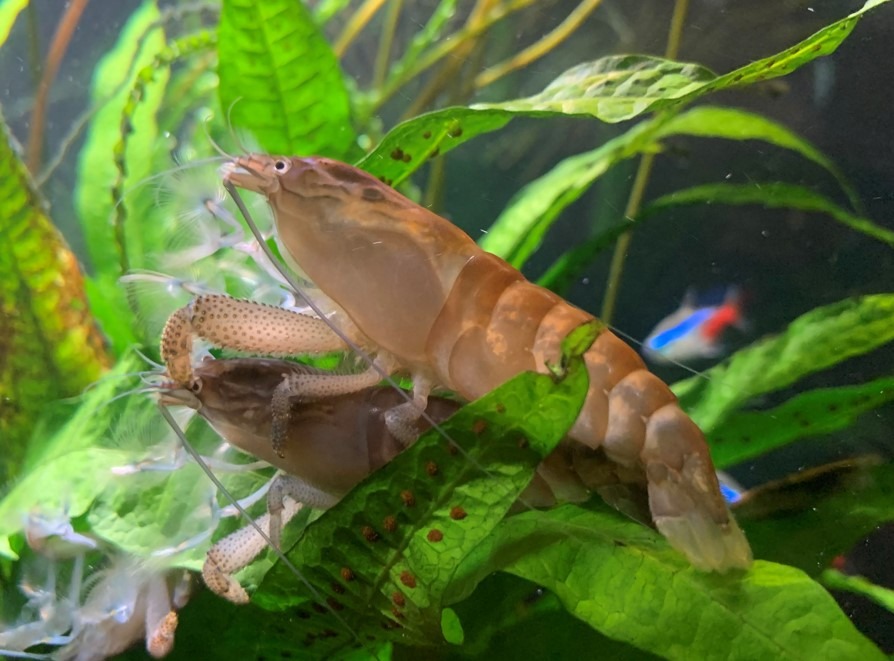
When it comes to vampire shrimp, there are a lot of different colors to choose from blue, grey, white, brown, or even pinkish. These species usually have little spikes on their legs and shell, which is a great detail and something different, compared to other smallest freshwater shrimp. Here is more information about vampire shrimp:
- Water Temperature: 22–28 °C (72–82 °F)
- pH: 6.5–7.5
- Water Hardness: 100—200 ppm
- Minimum Tank Size: 20 gallons
- Stocking: 1 vampire shrimp per 20 gallons
- Diet: Omnivorous (can eat blanched vegetables, algae, sinking pellets, blood worms, algae, and deceased fish)
- Lifespan: 4-5 years
- Size: up to 6 inches
- Care Level: Easy
Similar to amano shrimp, these species also need brackish water to successfully breed, so there is little chance, that you would have vampire shrimp babies with only a freshwater tank setup. Nevertheless, vampire shrimp are relatively large, and express a lot of emotions, which makes them the perfect pet.
Frequently Asked Questions
Can I Keep Different Freshwater Shrimp Species Together?
There is no problem in keeping different shrimp species together if the water parameters are good for both shrimp types. Another factor you might need to consider is that the shrimp types are peaceful. For example, you can’t keep whisker shrimp with neocaridina shrimp, since whisker shrimp portray aggressive behavior most of the time.
Do Freshwater Shrimp Need a Filter?
It is highly recommended to have a filter, even while keeping freshwater shrimp. Most species produce very little bioload, but having clean water is a priority, and a filter can help achieve that.
Writer's Thoughts
I absolutely love shrimp, especially all the colorful ones, since they are a great addition to a cool-looking aquarium. I hope this short smallest freshwater shrimp list will help you make up your mind on whether you want any of these shrimp species in your tank.
If you enjoyed reading my article, please feel free to share it with your friends by clicking the social media buttons below:
